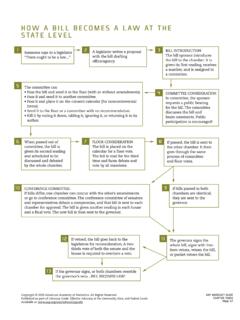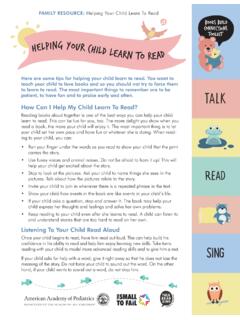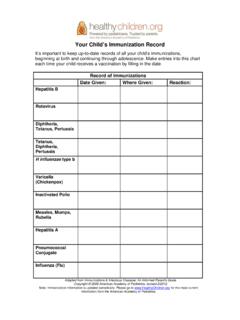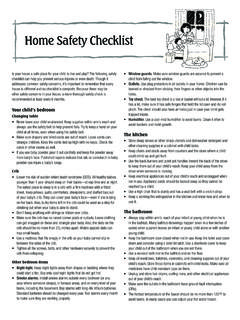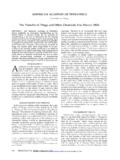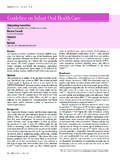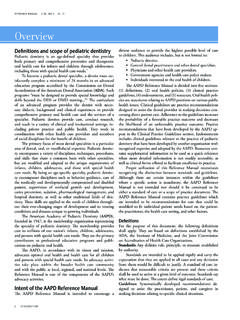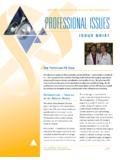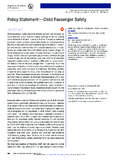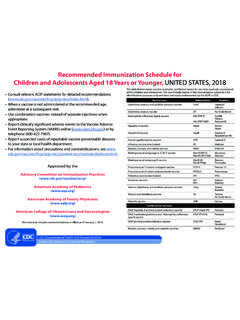Transcription of Bright Futures/American Academy of Pediatrics - AAP.org
1 INFANCYEARLY CHILDHOODMIDDLE CHILDHOODADOLESCENCEAGE1 Prenatal2 Newborn33-5 d4By 1 mo2 mo4 mo6 mo9 mo12 mo15 mo18 mo24 mo30 mo3 y4 y5 y6 y7 y8 y9 y10 y11 y12 y13 y14 y15 y16 y17 y18 y19 y20 y21 yHISTORY Initial/Intervalll l l l l l l l l l l l l l l l l l l l l l l l l l l l l l lMEASUREMENTSL ength/Height and Weightl l l l l l l l l l l l l l l l l l l l l l l l l l l l l l lHead Circumferencel l l l l l l l l l lWeight for Lengthl l l l l l l l l lBody Mass Index5l l l l l l l l l l l l l l l l l l l l lBlood Pressure6 l l l l l l l l l l l l l l l l l l lSENSORY SCREENINGV ision7 l l l l l l l l Hearing l8 l9 l l l l ll10llDEVELOPMENTAL/BEHAVIORAL HEALTHD evelopmental Screening11lllAutism Spectrum Disorder Screening12l lDevelopmental Surveillancel l l l l ll lll l l l l l l l l l l l l l l l l l lPsychosocial/Behavioral Assessment13l l l l l l l l l l l l l l l l l l l l l l l l l l l l l l lTobacco, Alcohol.
2 Or Drug Use Assessment14 Depression Screening15l l l l l l l l l lMaternal Depression Screening16l l l lPHYSICAL EXAMINATION17l l l l l l l l l l l l l l l l l l l l l l l l l l l l l l lPROCEDURES18 Newborn Blood l19 l20 Newborn Bilirubin21lCritical Congenital Heart Defect22lImmunization23l l l l l l l l l l l l l l l l l l l l l l l l l l l l l l lAnemia24 l Lead25 l or 26 l or 26 Tuberculosis27 Dyslipidemia28 l lSexually Transmitted Infections29 HIV30 l Cervical Dysplasia31lORAL HEALTH32 l33 l33 Fluoride Varnish34lFluoride Supplementation35 ANTICIPATORY GUIDANCEll l l l l l l l l l l l l l l l l l l l l l l l l l l l l l lEach child and family is unique; therefore, these Recommendations for Preventive pediatric Health Care are designed for the care of children who are receiving competent parenting, have no manifestations of any important health problems, and are growing and developing in a satisfactory fashion.
3 Developmental, psychosocial, and chronic disease issues for children and adolescents may require frequent counseling and treatment visits separate from preventive care visits. Additional visits also may become necessary if circumstances suggest variations from normal. These recommendations represent a consensus by the american Academy of Pediatrics (AAP) and Bright Futures. The AAP continues to emphasize the great importance of continuity of care in comprehensive health supervision and the need to avoid fragmentation of to the specific guidance by age as listed in the Bright Futures Guidelines (Hagan JF, Shaw JS, Duncan PM, eds. Bright Futures: Guidelines for Health Supervision of Infants, Children, and Adolescents. 4th ed. Elk Grove Village, IL: american Academy of Pediatrics ; 2017). The recommendations in this statement do not indicate an exclusive course of treatment or standard of medical care. Variations, taking into account individual circumstances, may be 2017 by the american Academy of Pediatrics , updated February part of this statement may be reproduced in any form or by any means without prior written permission from the american Academy of Pediatrics except for one copy for personal for Preventive pediatric Health CareBright Futures/American Academy of PediatricsKEY: l = to be performed = risk assessment to be performed with appropriate action to follow, if positivel= range during which a service may be provided1.
4 If a child comes under care for the first time at any point on the schedule, or if any items are not accomplished at the suggested age, the schedule should be brought up-to-date at the earliest possible A prenatal visit is recommended for parents who are at high risk, for first-time parents, and for those who request a conference. The prenatal visit should include anticipatory guidance, pertinent medical history, and a discussion of benefits of breastfeeding and planned method of feeding, per The Prenatal Visit ( ). 3. Newborns should have an evaluation after birth, and breastfeeding should be encouraged (and instruction and support should be offered).4. Newborns should have an evaluation within 3 to 5 days of birth and within 48 to 72 hours after discharge from the hospital to include evaluation for feeding and jaundice. Breastfeeding newborns should receive formal breastfeeding evaluation, and their mothers should receive encouragement and instruction, as recommended in Breastfeeding and the Use of Human Milk ( ).
5 Newborns discharged less than 48 hours after delivery must be examined within 48 hours of discharge, per Hospital Stay for Healthy Term Newborns ( ). 5. Screen, per Expert Committee Recommendations Regarding the Prevention, Assessment, and Treatment of Child and Adolescent Overweight and Obesity: Summary Report ( ).6. Blood pressure measurement in infants and children with specific risk conditions should be performed at visits before age 3 years. 7. A visual acuity screen is recommended at ages 4 and 5 years, as well as in cooperative 3-year-olds. Instrument-based screening may be used to assess risk at ages 12 and 24 months, in addition to the well visits at 3 through 5 years of age. See Visual System Assessment in Infants, Children, and Young Adults by Pediatricians ( ) and Procedures for the Evaluation of the Visual System by Pediatricians ( ).8. Confirm initial screen was completed, verify results, and follow up, as appropriate.
6 Newborns should be screened, per Year 2007 Position Statement: Principles and Guidelines for Early Hearing Detection and Intervention Programs ( ). 9. Verify results as soon as possible, and follow up, as Screen with audiometry including 6,000 and 8,000 Hz high frequencies once between 11 and 14 years, once between 15 and 17 years, and once between 18 and 21 years. See The Sensitivity of Adolescent Hearing Screens Significantly Improves by Adding High Frequencies ( (16)00048-3/fulltext).11. See Identifying Infants and Young Children With Developmental Disorders in the Medical Home: An Algorithm for Developmental Surveillance and Screening ( ).12. Screening should occur per Identification and Evaluation of Children With Autism Spectrum Disorders ( ).13. This assessment should be family centered and may include an assessment of child social-emotional health, caregiverdepression, and social determinants of health. See Promoting Optimal Development: Screening for Behavioral and Emotional Problems ( ) and Poverty and Child Health in the United States ( ).
7 14. A recommended assessment tool is available at screening using the Patient Health Questionnaire (PHQ)-2 or other tools available in the GLAD-PC toolkit and at ) should occur per Incorporating Recognition and Management of Perinatal and Postpartum Depression Into pediatric Practice ( ). each visit, age-appropriate physical examination is essential, with infant totally unclothed and older children undressed and suitably draped. See Use of Chaperones During the Physical Examination of the pediatric Patient ( ). may be modified, depending on entry point into schedule and individual need.(continued)Summary of Changes Made to the Bright Futures/AAP Recommendations for Preventive pediatric Health Care(Periodicity Schedule)This schedule reflects changes approved in February 2017 and published in April 2017. For updates, visit For further information, see the Bright Futures Guidelines, 4th Edition, Evidence and Rationale chapter ( ).
8 CHANGES MADE IN FEBRUARY 2017 HEARING Timing and follow-up of the screening recommendations for hearing during the infancy visits have been delineated. Adolescent risk assessment has changed to screening once during each time period. Footnote 8 has been updated to read as follows: Confirm initial screen was completed, verify results, and follow up, as appropriate. Newborns should be screened, per Year 2007 Position Statement: Principles and Guidelines for Early Hearing Detection and Intervention Programs ( ). Footnote 9 has been added to read as follows: Verify results as soon as possible, and follow up, as appropriate. Footnote 10 has been added to read as follows: Screen with audiometry including 6,000 and 8,000 Hz high frequencies once between 11 and 14 years, once between 15 and 17 years, and once between 18 and 21 years. See The Sensitivity of Adolescent Hearing Screens Significantly Improves by Adding High Frequencies ( (16)00048-3/fulltext).
9 PSYCHOSOCIAL/BEHAVIORAL ASSESSMENT Footnote 13 has been added to read as follows: This assessment should be family centered and may include an assessment of child social-emotional health, caregiver depression, and social determinants of health. See Promoting Optimal Development: Screening for Behavioral and Emotional Problems ( ) and Poverty and Child Health in the United States ( ). TOBACCO, ALCOHOL, OR DRUG USE ASSESSMENT The header was updated to be consistent with SCREENING Adolescent depression screening begins routinely at 12 years of age (to be consistent with recommendations of the US Preventive Services Task Force [USPSTF]).MATERNAL DEPRESSION SCREENING Screening for maternal depression at 1-, 2-, 4-, and 6-month visits has been added. Footnote 16 was added to read as follows: Screening should occur per Incorporating Recognition and Management of Perinatal and Postpartum Depression Into pediatric Practice ( ).
10 NEWBORN BLOOD Timing and follow-up of the newborn blood screening recommendations have been delineated. Footnote 19 has been updated to read as follows: Confirm initial screen was accomplished, verify results, and follow up, as appropriate. The Recommended Uniform Newborn Screening Panel ( ), as determined by The Secretary s Advisory Committee on Heritable Disorders in Newborns and Children, and state newborn screening laws/regulations ( ) establish the criteria for and coverage of newborn screening procedures and programs. Footnote 20 has been added to read as follows: Verify results as soon as possible, and follow up, as appropriate. NEWBORN BILIRUBIN Screening for bilirubin concentration at the newborn visit has been added. Footnote 21 has been added to read as follows: Confirm initial screening was accomplished, verify results, and follow up, as appropriate. See Hyperbilirubinemia in the Newborn Infant 35 Weeks Gestation: An Update With Clarifications ( ).

